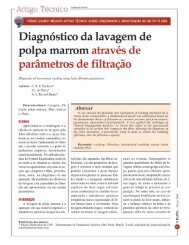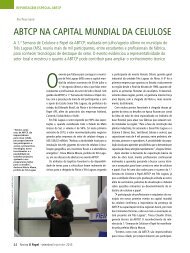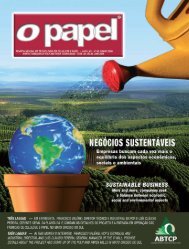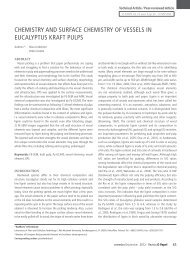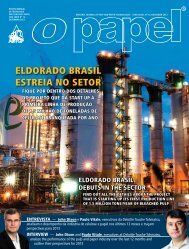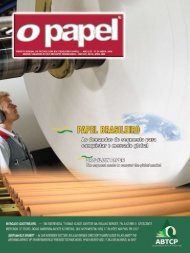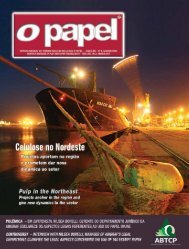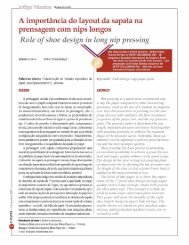international article - Revista O Papel
international article - Revista O Papel
international article - Revista O Papel
You also want an ePaper? Increase the reach of your titles
YUMPU automatically turns print PDFs into web optimized ePapers that Google loves.
lhante a um sistema ideal no estágio inicial, pois as perdas<br />
térmicas ambientais, causadas por diferenças de temperatura,<br />
são pequenas - ver Figura 8. Isto implica o fato de que uma<br />
esmagadora maioria, ou até mesmo a totalidade da energia<br />
mecânica de refinação fornecida, no final foi convertida<br />
em calor, e contradiz a afirmação: “…a contribuição da<br />
potência sem carga não é totalmente convertida em calor“,<br />
feita anteriormente (Basile 1984). O autor fez referência<br />
ao trabalho de Amero (1980), no qual se considerou que a<br />
potência sem carga aumentava a drenagem da polpa. Levlin<br />
(1988) argumentou que a potência de funcionamento sem<br />
carga produz certo grau de refinação das fibras. Portanto,<br />
a contribuição da potência sem carga introduz energia que<br />
produz alterações (de pequena monta) nas fibras e que no fim<br />
é convertida em calor. Siewert e Selder (1980) procederam<br />
a uma decomposição semelhante da potência do refinador.<br />
Eles propuseram que a parcela da potência do refinador que<br />
contribui para o consumo de energia da circulação de massa,<br />
medida como nível de potência sem carga com massa,<br />
se reduz em função do grau de refinação. Tal redução pode<br />
se dever a modificações das fibras, resultando em crescente<br />
flexibilidade das mesmas, a qual reduz a resistência da rede<br />
das fibras (Wikström 2002). Da mesma forma, uma temperatura<br />
mais elevada reduz a viscosidade da água.<br />
Visando a simplificação, a potência medida do eixo do<br />
system in the early stage as the environmental heat<br />
losses caused by temperature differences are small,<br />
Figure 8. This implies that a large majority or even<br />
all of the supplied mechanical refining energy in<br />
the end was converted into heat, and contradicts<br />
the statement: “…the no load power contribution is<br />
not totally converted into heat" earlier made (Basile<br />
1984). The author referred to the work of Amero<br />
(1980) where the no load power was seen to increase<br />
the pulp drainage. Levlin (1988) argued that the<br />
idling power induces a certain amount of refining<br />
to the fibres. The no load power contribution thus<br />
introduces energy that produces (minor) changes<br />
in fibres and that in the end is converted into heat.<br />
Siewert and Selder (1980) made a similar breakdown<br />
of the refiner power. They proposed that the refiner<br />
power share contributing to the energy consumption<br />
of stock circulation, measured as no-load power<br />
level with stock, decreases with degree of refining.<br />
Such a reduction can be due to fibre modifications<br />
leading to increasing fibre flexibility that reduces the<br />
network strength of the fibres (Wikström 2002). Also<br />
a higher temperature will reduce the water viscosity.<br />
For simplification, the measured refiner shaft<br />
power was considered a constant, and an average<br />
4% Polpa ECF 2<br />
, Rotor LM 2<br />
: 2250 rpm, 2,7 J/m / 4% ECF - pulp, LM -fillings : 2250 rpm, 2.7 J/m<br />
2 2<br />
O PAPEL vol. 70, num. 10, pp. 41 - 60 OCT 2009<br />
W de entrada<br />
/ W in<br />
E Fibras<br />
/ E Fibres<br />
E Susp.<br />
/ E Susp.<br />
F Em vazio<br />
/ F Idl<br />
Sistema ideal / Ideal system<br />
Trabalho do eixo / Shaft work<br />
Perdas em funcionamento sem carga<br />
(susp.) / Idling losses (susp.)<br />
Perdas em funcionamento sem carga<br />
(água) / Idling losses (water)<br />
Perdas nos mancais / Bearing losses<br />
O PAPEL - Outubro 2009<br />
52<br />
Tempo (t) / Time (t)<br />
F Mec<br />
/ F Mech<br />
Figura 8. Um exemplo de uma decomposição estimativa de energia por componentes de dissipação: o trabalho do eixo de entrada, W in<br />
; a energia<br />
de modificação das fibras, E Fibres<br />
, que inclui o trabalho consumido pelas interações entre as fibras, E Susp<br />
; as perdas de potência de funcionamento<br />
sem carga (determinadas somente com água), T Idl<br />
; e as perdas nos mancais, F Mech<br />
. Os dados não são do presente trabalho; gráfico de (Lundin 2008)<br />
Figure 8. An example of an estimative energy breakdown by dissipation components: the input shaft work, W in<br />
; the fibre modification energy,<br />
E Fibres<br />
, which includes the work consumed by the fibre-fibre interactions, E Susp<br />
; the idling power losses (as determined with water only), T Idl<br />
; and<br />
the bearing losses, F Mech<br />
. Data not from present paper; graph from (Lundin 2008)



